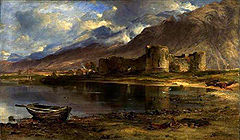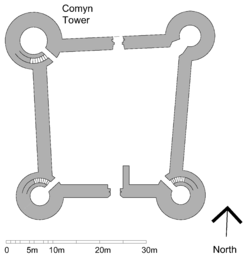
Inverlochy Castle
Encyclopedia




Scotland
Scotland is a country that is part of the United Kingdom. Occupying the northern third of the island of Great Britain, it shares a border with England to the south and is bounded by the North Sea to the east, the Atlantic Ocean to the north and west, and the North Channel and Irish Sea to the...
. The site of two battles, the castle remains largely unchanged since its construction. It is now in the care of Historic Scotland
Historic Scotland
Historic Scotland is an executive agency of the Scottish Government, responsible for historic monuments in Scotland.-Role:As its website states:...
.
History
Inverlochy Castle was built circaCirca
Circa , usually abbreviated c. or ca. , means "approximately" in the English language, usually referring to a date...
1270-1280 by John "the Black" Comyn
John II Comyn, Lord of Badenoch
John II Comyn, Lord of Badenoch and Lord of Lochaber or John "the Black", also known as Black Comyn, a Scottish nobleman, was a Guardian of Scotland, and one of the six Regents for Margaret, Maid of Norway...
, Lord of Badenoch
Badenoch
Badenoch is a traditional district which today forms part of Badenoch and Strathspey, an area of Highland Council, in Scotland, bounded on the north by the Monadhliath Mountains, on the east by the Cairngorms and Braemar, on the south by Atholl and the Grampians, and on the west by Lochaber...
and Lochaber
Lochaber
District of Lochaber 1975 to 1996Highland council area shown as one of the council areas of ScotlandLochaber is one of the 16 ward management areas of the Highland Council of Scotland and one of eight former local government districts of the two-tier Highland region...
, and chief of the Clan Comyn. It may have been built on the site of an earlier Pict
PICT
PICT is a graphics file format introduced on the original Apple Macintosh computer as its standard metafile format. It allows the interchange of graphics , and some limited text support, between Mac applications, and was the native graphics format of QuickDraw.The original version, PICT 1, was...
ish fortification and settlement, which the historian Hector Boece
Hector Boece
Hector Boece , known in Latin as Hector Boecius or Boethius, was a Scottish philosopher and first Principal of King's College in Aberdeen, a predecessor of the University of Aberdeen.-Biography:He was born in Dundee where he attended school...
(1465-1536) records as a "city" that was destroyed by Vikings. When Robert the Bruce succeeded to the Scottish throne in 1306, the Comyns, his rivals for the crown, were dispossessed, and the castle was unoccupied for a time. In 1431, clansmen of Alexander MacDonald
Alexander of Islay, Earl of Ross
Alexander of Islay or Alexander MacDonald was a medieval Scottish nobleman, who succeeded his father Domhnall of Islay as Lord of the Isles and rose to the rank of Earl of Ross...
, Lord of the Isles
Lord of the Isles
The designation Lord of the Isles is today a title of Scottish nobility with historical roots that go back beyond the Kingdom of Scotland. It emerged from a series of hybrid Viking/Gaelic rulers of the west coast and islands of Scotland in the Middle Ages, who wielded sea-power with fleets of...
, defeated King James I's
James I of Scotland
James I, King of Scots , was the son of Robert III and Annabella Drummond. He was probably born in late July 1394 in Dunfermline as youngest of three sons...
larger army in the first Battle of Inverlochy
Battle of Inverlochy (1431)
The Battle of Inverlochy was fought after Alexander of Islay , Lord of the Isles and Earl of Ross, had been imprisoned by King James I...
, fought close by the castle.
In 1505, the partially ruined castle was granted to George Gordon, 2nd Earl of Huntly
George Gordon, 2nd Earl of Huntly
George Gordon, 2nd Earl of Huntly was Chancellor of Scotland from 1498–1501.Gordon fought on the King's side against the Douglases during The Douglas Rebellion and helped secure a defeat at the Battle of Brechin. The 2nd Earl completed the building work that his father begun in constructing Huntly...
, who was charged by King James IV
James IV of Scotland
James IV was King of Scots from 11 June 1488 to his death. He is generally regarded as the most successful of the Stewart monarchs of Scotland, but his reign ended with the disastrous defeat at the Battle of Flodden Field, where he became the last monarch from not only Scotland, but also from all...
with repairing the castle for use as a Royal garrison. In 1645, the castle served as a stopping-off point for the royalist
Cavalier
Cavalier was the name used by Parliamentarians for a Royalist supporter of King Charles I and son Charles II during the English Civil War, the Interregnum, and the Restoration...
army of James Graham, 1st Marquess of Montrose
James Graham, 1st Marquess of Montrose
James Graham, 1st Marquess of Montrose was a Scottish nobleman and soldier, who initially joined the Covenanters in the Wars of the Three Kingdoms, but subsequently supported King Charles I as the English Civil War developed...
during his campaign against the Covenanter
Covenanter
The Covenanters were a Scottish Presbyterian movement that played an important part in the history of Scotland, and to a lesser extent in that of England and Ireland, during the 17th century...
forces of the Marquess of Argyll
Archibald Campbell, 1st Marquess of Argyll
Archibald Campbell, 1st Marquess of Argyll, 8th Earl of Argyll, chief of Clan Campbell, was the de facto head of government in Scotland during most of the conflict known as the Wars of the Three Kingdoms, also known as the British Civil War...
. This culminated in a victory for the royalists in the second Battle of Inverlochy
Battle of Inverlochy (1645)
The Battle of Inverlochy was a battle of the Scottish Civil War in which Montrose routed the pursuing forces of the Marquess of Argyll....
, on February 2, 1645. In the 19th century, the estate was bought by James Scarlett, 1st Baron Abinger
James Scarlett, 1st Baron Abinger
James Scarlett, 1st Baron Abinger was an English lawyer, politician and judge.-Background and education:...
, who built a Scottish baronial style
Scottish baronial style
The Scottish Baronial style is part of the Gothic Revival architecture style, using stylistic elements and forms from castles, tower houses and mansions of the Gothic architecture period in Scotland, such as Craigievar Castle and Newark Castle, Port Glasgow. The revival style was popular from the...
mansion to the north-west, which is now the Inverlochy Castle Hotel
Inverlochy Castle Hotel
Inverlochy Castle Hotel is a 19th-century baronial mansion near Fort William, Scotland. It is located about two miles away from the 13th century Inverlochy Castle, after which it was named. This is a baronial mansion was built in 1863 by James Scarlett, 1st Baron Abinger...
. Minor enhancements, including the restoration of loops
Embrasure
In military architecture, an embrasure is the opening in a crenellation or battlement between the two raised solid portions or merlons, sometimes called a crenel or crenelle...
and battlement
Battlement
A battlement in defensive architecture, such as that of city walls or castles, comprises a parapet , in which portions have been cut out at intervals to allow the discharge of arrows or other missiles. These cut-out portions form crenels...
s, were carried out by Lord Abinger in advance of the visit of Queen Victoria in 1873.
Description
Inverlochy is now a ruin, but is unusual because it has remained unaltered since it was built in the reign of King Alexander IIIAlexander III of Scotland
Alexander III was King of Scots from 1249 to his death.-Life:...
. The castle is sited on the south bank of the River Orchy
River Orchy
The River Orchy is located in Dalmally, Argyll, Scotland. It rises in the Black Mount Forest, passes through Loch Tulla and Glen Orchy before reaching Loch Awe. There are falls and islands within the river...
, at the strategically important entrance to the Great Glen
Great Glen
The Great Glen , also known as Glen Albyn or Glen More is a series of glens in Scotland running 100 kilometres from Inverness on the Moray Firth, to Fort William at the head of Loch Linnhe.The Great Glen follows a large geological fault known as the Great Glen Fault...
, a key passage through the Scottish Highlands
Scottish Highlands
The Highlands is an historic region of Scotland. The area is sometimes referred to as the "Scottish Highlands". It was culturally distinguishable from the Lowlands from the later Middle Ages into the modern period, when Lowland Scots replaced Scottish Gaelic throughout most of the Lowlands...
. With one side defended by the river, the castle's other three sides were originally protected by a water-filled ditch. Inverlochy is a castle of enceinte
Enceinte
Enceinte , is a French term used technically in fortification for the inner ring of fortifications surrounding a town or a concentric castle....
, with its main defence being a substantial curtain wall
Curtain wall (fortification)
A curtain wall is a defensive wall between two bastions of a castle or fortress.In earlier designs of castle the curtain walls were often built to a considerable height and were fronted by a ditch or moat to make assault difficult....
. The simple layout comprises a quadrangular courtyard, 31 by across, surrounded by a wall up to 2.7 metres (8.9 ft) thick and up to 7.6 metres (24.9 ft) high, with round towers at each corner. The largest of these, known as the Comyn Tower, is 6.1 metres (20 ft) across the interior, and served as the castle's "donjon", or keep
Keep
A keep is a type of fortified tower built within castles during the Middle Ages by European nobility. Scholars have debated the scope of the word keep, but usually consider it to refer to large towers in castles that were fortified residences, used as a refuge of last resort should the rest of the...
. The smaller towers are 14 feet (4.3 m), and all four have stairways curving up within the thickness of the walls. The main entrance was to the south, with a "water gate" facing the river to the north. Both entrances were defended by a portcullis
Portcullis
A portcullis is a latticed grille made of wood, metal, fibreglass or a combination of the three. Portcullises fortified the entrances to many medieval castles, acting as a last line of defence during time of attack or siege...
, and the south door may have had an interior gatehouse.

